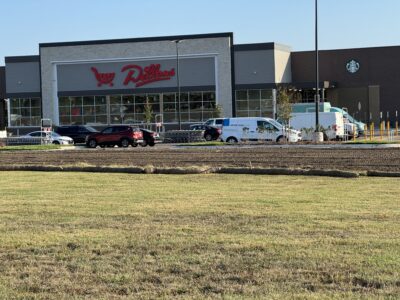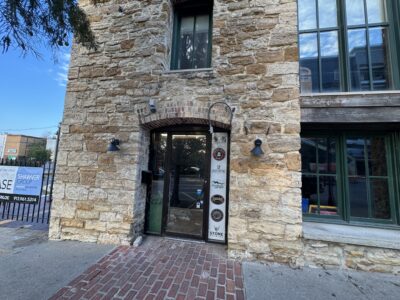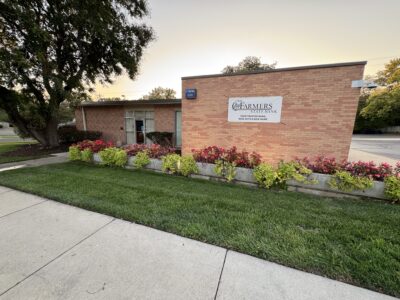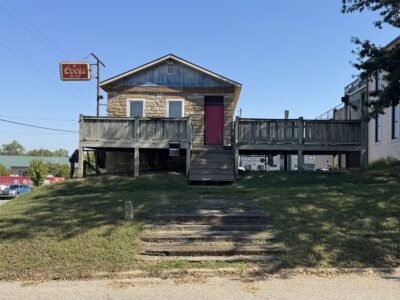
A deeper look at spending, revenue trends for City of Lawrence as it gets ready to approve its budget
Water and sewer revenue up 41% since 2015, topping both sales and property taxes

photo by: Shawn Valverde/Special to the Journal-World
Downtown Lawrence, looking north, is pictured in this aerial photo from September 2023.
Whether you hang out at beaches or local government boardrooms (which one leaves you redder is a debate for another day) the Labor Day weekend is an unofficial marker. For the beach bums, it marks the unofficial end of summer. For the government gurus, it marks the beginning of the end of budget season.
Douglas County commissioners earlier this week approved the county’s 2026 budget with a slight property tax rate decrease. On Tuesday, Lawrence city commissioners will hold their state-required public hearing on the city’s 2026 budget, which is one of the final steps before the budget will be up for approval at the Sept. 16 meeting.
Whether the city will end up with a lower property tax rate is unclear. The proposed budget calls for an increase of about three-quarters of a mill in the property tax rate, which would amount to about a $40 increase in property taxes for the owner of a $500,000 home. Whether commissioners stick with that proposal or lower it is what will be determined over the next couple of weeks.
Commissioners, as you would expect, will be going over lots of here-and-now issues as they determine what path to take — what immediate needs does one department have versus another, what programs should be expanded, what user fees should be added, and a host of other issues of the day.
Budget season, though, also can be a time to look at bigger-picture issues and changing trends for a government, which often involves looking backward more than looking forward.
Having covered budget deliberations for more than 30 years, I can say budget seasons are a natural time for such discussions, but they don’t happen very often. But in the case of the City of Lawrence, it does do a good job of making the historical information available to review. The City of Lawrence does routinely get its previous year’s financial audit completed prior to asking city commissioners to take action on next year’s budget. That financial audit — which serves as the official financial statements for the city — is probably the best way to see big trends and financial changes that are impacting the city.
I wrote a report on some of the top line findings of the audit when it came out in early August. The big item from that report was: In 2024 city expenses grew nearly twice as fast as revenues, and for every new dollar in spending, more than 60 cents of it went to public works projects.
That’s good information to know about 2024 finances, but the audit has much more info than that, and also looks back further into the city’s finances to measure trends. City commissioners reviewed the 2024 audit earlier this month, but really not in much detail. Granted, it is not the best beach reading, but as the city is crawling out of a budget shortfall and other financial challenges, it does seem like a good document to go over in more detail.
I’ve read the approximately 170 pages of the document, and here are some of the bigger-picture trends that caught my eye. I’m not going to use this piece to provide any analysis of what the city should or shouldn’t be doing as a result of these trends. That’s a different type of discussion that should involve residents, commissioners, city staff members and likely more context than what a financial statement alone can provide. But highlighting some trends seems like a good starting point:
Here’s how much the city spent in 2024 on certain types of services and activities, and how those expenses compare to 2020 and 2015 totals:
• General government: $24.0 million, down 14% from 2020, down 18% from 2015
• Public safety: $70.1 million, up 27% and 112%
• Public works: $37.7 million; up 50% and 88%
• Health and social services: $15.3 million; up 255% and 750%
• Culture and recreation: $28.0 million; up 112% and 182%
• Tourism: $1.4 million; down 12% and 17%
• Water and sewer: $58.7 million; up 28% and 82%
• Sanitation: $18.3 million; up 33% and 67%
• Stormwater: $6.0 million; up 66% and 252%
• Total: $268.4 million; up 34% and 83%
As I mentioned earlier, additional context will be useful with some of these numbers. Case in point, general government expenses — think of it like a business’ overhead — did not actually go down during the last decade. Rather, I believe, some of those expenses got recategorized. So, some of the other line items above likely increased to some degree because of those recategorized expenses.
Nonetheless, the numbers above do provide some useful trend information. For example, compare the percentages of various departments to the percentages for the total spending line at the bottom. That’s a quick way to see which areas grew at an above-average or a below-average pace. Sometimes it also reveals a mixed bag. For example, public safety grew at an above-average pace for the decade but has grown at a below-average pace since 2020. Others have been growing strongly throughout both halves of the decade, with culture and recreation spending and health and social service spending being the best examples. Those were the two categories that posted 100%-plus growth rates for both periods.
Here’s a similar look at how key revenues have grown during the same time period.
• Property taxes: $52.9 million; up 22% since 2020 and 75% since 2015
• Sales taxes: $61.7 million; up 36% and 71%
• Franchise taxes: $8.5 million; up 25% and 19%
• Water and sewer fees: $69.1 million; up 41% and 94%
• Sanitation fees: $18.8 million; up 27% and 50%
• Stormwater fee: $6.7 million; up 76% and 123%
I’m not sure many people would have guessed that sales tax revenues have increased at a greater rate than property tax revenues since 2015. After all, home values have soared during that time, which has caused property tax bills to go up. However, inflation also has soared during that time, which causes sales tax collections to increase. Remember when eggs were approximately the price of a Lexus? Well, you were paying more in sales tax as a result of those higher prices but you just didn’t have the chance to notice because you were busy selling your plasma to pay for the eggs.
The most interesting number might be the water and sewer figure, especially when you compare it to the expense figures above. Water and sewer revenues have been going up quite a bit faster than water and sewer expenses. Since 2015, revenue is up 41% while expenses are up 28%. The department is accumulating cash to help pay for big capital projects — like a $70 million upgrade of the sewage treatment plant on the Kansas River that is underway. However, rising water and sewer rates also have been one of the more consistent complaints of residents over the last few years. The numbers show water and sewer rates have been increasing far more than property taxes, for example. The stormwater fee the city charges, however, has actually been the area with the largest increase. It doesn’t get much attention, in part because it shows up on the same bill with your water and sewer fees. Many residents probably just view that as one expense.
The financial audit probably does the best job of showing the big picture of how much debt the city has at any given time. The financial statements combine all types of debt — bonds, notes, financing agreements, leases and other types of obligations — in a way that you don’t often see in other documents. The 2024 audit shows how that debt total has been growing in some meaningful ways.
That makes sense because a hallmark of the administration of City Manager Craig Owens has been to get aggressive in replacing aging infrastructure. Those capital projects — roads, sewer lines, new buildings — often require the issuance of debt. Here’s a look at the total debt amount for the city and what that equates to in the amount of debt per capita.
• 2024: $435.6 million in debt, $4,528 per capita
• 2020: $316.8 million, $3,338
• 2015: $243.5 million, $2,585
The other thing the audit tries to do is measure how debt has grown compared to how incomes in the community have grown. That’s important because, after all, it primarily is residents who ultimately pay for the debt through either taxes or fees.
The audit tries to measure that by comparing the amount of per capita debt to the average amount of per capita personal income of Lawrence residents. In 2024, city debt amounted to 6.36% of personal income. That’s the highest percentage since 2017, when it hit 6.47%. Since 2015, the median amount has been 6.12%.







